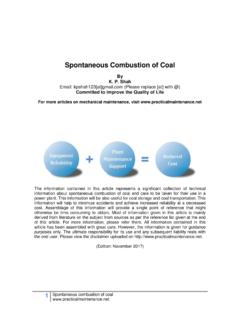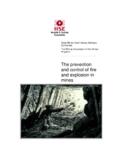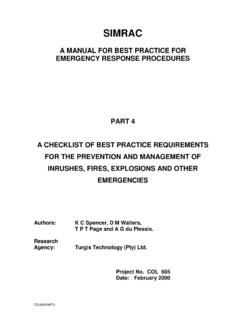Transcription of Commercial Coal-mining in Natal: A CentennialAppraisal
1 41 Commercial Coal-mining in natal : A CentennialAppraisal1 Origins The large-scale Commercial exploitation of northern natal 's coal deposits was initiated by the formation in January 1889 of the Dundee ( natal ) Coal Company under the chairmanship of the highly-successful Durban businessman and civic leader, Benjamin Greenacre. For half a century following the arrival of the Voortrekkers in the late 1830s numerous outcrops of coal had been haphazardly exploited for domestic consumption by the white farming community of the region and, from the 1840s, small consignments had been transported for sale as far afield as Pietermaritzburg.
2 Deposits had been found on several properties in the Newcastle vicinity, along the Biggarsberg, near Ladysmith and, in limited quantities, in the Msinga district, on the Mvoti and Thukela rivers, and at Compensation on the coastline north of Durban. 2 By the 1880s Klip River County, in the Newcastle magisterial division, had emerged as that part of natal with the most obvious mining potential and Dundee,3 where Peter Smith had initiated mining activity on the eastern slope of Talana hill, was already recognised as the Colony's coal capital, being geographically central to the Klip River coalfield in which, prior to the 1930s, most of natal 's Coal-mining took place.
3 The full potential of that coalfield could still only be guessed at, and the Colony's rudimentary wagon roads made it impossible to contemplate the transportation of any commodity in bulk except during the dry winter months. Two events facilitated the development of Commercial mining operations in the region. In September 1881 Frederick W. North, the British geological expert who had been appointed by Lieutenant-Governor Sir Henry Bulwer to investigate natal 's coal resources, attracted much attention to the region by reporting that Klip River County was endowed with a workable coalfield which was no less than 1350 square miles (3 496,5 square kilometres) in extent and contained 2073 million tons of coal, much of it suitable for generating steam in locomotives.
4 Then, in 1889, the railway from Durban through Pietermaritzburg and Ladysmith at last advanced through Glencoe and Newcastle en route towards the Transvaal border. It was not the confirmed potential of the Klip River coalfield which promoted railway construction into the northern reaches of the Colony but the discovery in 1886 of the main Witwatersrand goldreef and a determination to ensure for natal a reasonable share of the trade bonanza that was expected to ensue from the anticipated development of a major gold-mining industry. Natalia 18 (1988) Copyright natal Society Foundation 2010-"'" N COALFIELDS OF natal NAMIBIA ~ ~ ~ ~ '";:s [ ~ ;::, 1111111111111111111 Coalf"'lds I -+---+-Railwa)'s s ~.]
5 0,= ! :!!. lO kilometres 40 !Ill s ~ I!MA"!I", : 43 Commercial Coal-mining in natal Greenacre's consortium of Durban merchants and shipowners was quick to invest in a private railway-line which linked their mining properties Coalfields and, subsequently, Talana at Dundee to the main line at Glencoe but the Company soon found itself in competition with others who were similarly alert to the Commercial possibilities of the region. In November 1889 Frederick North re-appeared in the Colony to secure several coal-bearing properties in the Newcastle vicinity on behalf of an unidentified English syndicate, and others followed in his wake.
6 The Hon. F. Reynolds, member for Alexandra County in natal 's Legislative Assembly, and S. Mitchell-Innes, who farmed in the Ladysmith district, established the Elandslaagte Colliery Company at the southern end of the Klip River coalfield, where they substantially reduced the cost of transporting coal to the port by acquiring a 45-year lease on good mining property which lay within 300 yards of the railway line. While the Dundee and Elandslaagte Companies proved to be two of natal 's more enduring mining enterprises, over half of the 60-odd collieries that were opened during the colonial era had closed by 1910 as a result of inexperience or of 'extravagant and unskilled management'.
7 Coal-mining attracted investors from a variety of occupations and initially very few of them had any appropriate expertise to apply. For example, the unsuccessful Lennoxton Colliery Company which mined in the vicinity of Newcastle was controlled by a syndicate that included a farmer, a local doctor, a commission agent and a storekeeper, while the neighbouring West Lennoxton Collieries Ltd also went downhill when one of its guarantors, the Durban tailor Simons, became Some of the Colony's mining companies did enjoy the advantage of being financially well connected. The natal Cambrian Collieries Ltd was controlled by 'an influential Directorate' which included Butcher, the senior partner in S.
8 Butcher and Sons of Durban, as well as the wealthy sugar magnate Smith, and Reynolds who owned extensive property on the natal coast. The South African Collieries Ltd was uniquely fortunate in being closely connected to and financially sustained by the De Beers Consolidated Mines Ltd, which subsequently took over its Northfield Colliery. Other enterprises, like the natal Navigation Collieries and Estate Company Ltd, Hattingspruit Collieries Ltd, and New Campbell Collieries Ltd, were either floated with Witwatersrand capital or taken over and managed by Johannesburg-based companies.
9 One mining company, the Enyati Colliery Ltd, was floated in Mauritius and some, including the Vryheid ( natal ) Railway Coal and Iron Company which developed the Hlobane Colliery, were financed and directed from London. While many of natal 's early colliery companies sought listings on the London Stock Exchange and attracted British investment capital, with varying degrees of success, most of them were financed and controlled by local entrepreneurs based in Durban. The Dundee ( natal ) Coal Company was therefore not unique in this respect, and although its board of directors was initially also lacking in mining expertise their prominence in the economic and political life of the Colony and their collective experience in commerce and shipping did offer some reassurance to prospective investors.
10 George Payne, Leuchars and the Hon. A. Mitchell Campbell were all, like their chairman Benjamin Greenacre, prosperous Durban merchants and civic leaders. Two other directors, Charles Hitchins and (from 1903) Otto Siedle were involved in shipping businesses while one, G .M. Sutton, owner through marriage of the 44 Commercial Coal-mining in natal property Coalfields, had an agricultural background and subsequently became Prime Minister ofNatal between August 1903 and May 1905. These influential Commercial and political connections doubtless helped the Company to maintain its initial pre-eminence in the natal coal industry but did not insulate it from the financial anxieties and fierce market competition to which its rivals were exposed.









